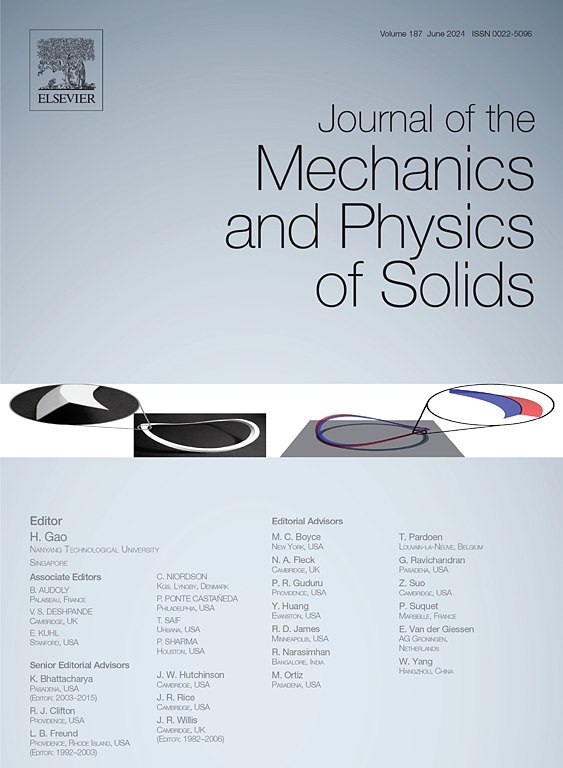二氧化碳诱导的动态共价聚合物网络力学:本构建模和裂纹愈合
IF 5
2区 工程技术
Q2 MATERIALS SCIENCE, MULTIDISCIPLINARY
引用次数: 0
摘要
二氧化碳诱导的动态共价聚合物网络(DCPNs)因其封存二氧化碳以重塑材料特性的能力而备受关注。尽管在聚合物中固碳的成功前景广阔,但人们对二氧化碳诱导聚合物网络的机理认识仍处于起步阶段。理解二氧化碳诱导的 DCPNs 体网络形成和界面裂缝愈合的理论框架尚未建立。在此,我们建立了一个基于聚合物网络的理论模型系统,可从机理上解释二氧化碳诱导 DCPN 的构成行为和裂纹愈合。我们假设 DCPN 由相互渗透的网络组成,这些网络由 CO2 诱导的动态键交联,并遵循力相关的化学动力学。在愈合过程中,我们认为二氧化碳分子会从表面扩散到裂纹界面,重新形成聚合物网络,从而实现界面修复。我们的理论框架可以计算原始 DCPN 和愈合 DCPN 的应力-应变行为。我们证明,理论计算得出的原始 DCPN 在不同二氧化碳浓度下的应力-应变响应,以及愈合的 DCPN 在不同二氧化碳浓度下的应力-应变响应,与记录的实验结果一致。我们希望我们的模型能成为创新、设计、理解和优化二氧化碳诱导的 DCPN 的宝贵工具。本文章由计算机程序翻译,如有差异,请以英文原文为准。
Mechanics of CO2-induced dynamic covalent polymer networks: Constitutive modeling and crack healing
CO2-induced dynamic covalent polymer networks (DCPNs) have received significant attention due to their capability of sequestering CO2 to remodel material properties. Despite the promising success of carbon sequestration in the polymer, the mechanistic understanding of the CO2-induced polymer network is still at the very beginning. A theoretical framework to understand the CO2-induced formation of bulk networks and healing of interfacial cracks of DCPNs has not been established. Here, we build up a polymer-network-based theoretical model system that can mechanistically explain the constitutive behavior and crack healing of CO2-induced DCPNs. We assume that the DCPN consists of interpenetrating networks crosslinked by CO2-induced dynamic bonds which follow a force-dependent chemical kinetics. During the healing process, we consider the CO2 molecules diffuse from the surface to the crack interface to reform the polymer network for interfacial repair. Our theoretical framework can calculate the stress-strain behaviors of both original and healed DCPNs. We demonstrate that the theoretically calculated stress-strain responses of the original DCPNs across various CO2 concentrations, as well as those of healed DCPNs under different CO2 concentrations, consistently match the documented experimental results. We expect our model to become an invaluable tool for innovating, designing, understanding, and optimizing CO2-induced DCPNs.
求助全文
通过发布文献求助,成功后即可免费获取论文全文。
去求助
来源期刊
CiteScore
9.80
自引率
9.40%
发文量
276
审稿时长
52 days
期刊介绍:
The aim of Journal of The Mechanics and Physics of Solids is to publish research of the highest quality and of lasting significance on the mechanics of solids. The scope is broad, from fundamental concepts in mechanics to the analysis of novel phenomena and applications. Solids are interpreted broadly to include both hard and soft materials as well as natural and synthetic structures. The approach can be theoretical, experimental or computational.This research activity sits within engineering science and the allied areas of applied mathematics, materials science, bio-mechanics, applied physics, and geophysics.
The Journal was founded in 1952 by Rodney Hill, who was its Editor-in-Chief until 1968. The topics of interest to the Journal evolve with developments in the subject but its basic ethos remains the same: to publish research of the highest quality relating to the mechanics of solids. Thus, emphasis is placed on the development of fundamental concepts of mechanics and novel applications of these concepts based on theoretical, experimental or computational approaches, drawing upon the various branches of engineering science and the allied areas within applied mathematics, materials science, structural engineering, applied physics, and geophysics.
The main purpose of the Journal is to foster scientific understanding of the processes of deformation and mechanical failure of all solid materials, both technological and natural, and the connections between these processes and their underlying physical mechanisms. In this sense, the content of the Journal should reflect the current state of the discipline in analysis, experimental observation, and numerical simulation. In the interest of achieving this goal, authors are encouraged to consider the significance of their contributions for the field of mechanics and the implications of their results, in addition to describing the details of their work.

 求助内容:
求助内容: 应助结果提醒方式:
应助结果提醒方式:


